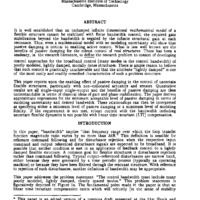-
Title
-
The Need for Passive Damping In Feedback Controlled Flexible Structures
-
Description
-
It is well established that an undamped infinite dimensional mathematical model of a flexible structure cannot be stabilized with finite bandwidth control; the required gain stabilization beyond the bandwidth is negated by the infinite structural gain at each resonance. Thus, even a mathematical model with no modeling uncertainty will show that passive damping is critical to enabling active control. What is less well known. are the benefits of passive damping for the robust control of real structures. There has been a tendency, in the research literature, to define the research problem to consist of developing control approaches for the broadband control (many modes in the control bandwidth) of poorly modeled, lightly damped, modally dense structures. There is ample reason to believe that such control is practically unachievable and that the attribute "lightly damped" is one of the most easily and readily remedied characteristics of such a problem structure. This paper reports upon the enabling effect of passive damping in the control of uncertain flexible structures, particularly with non-collocated actuators and sensors. Quantitative results are all single-input single-output and the benefits of passive damping are then understandable in terms of classical ideas of gain and phase stabilization. The paper derives approximate expressions for the minimum acceptable level of passive damping in terms of modeling uncertainty and desired bandwidth. These relationships can then be interpreted as specifying either a minimum level of passive damping or a minimum level of modeling fidelity. If the requirement is not met, robust control with the bandwidth including uncertain flexible dynamics is not possible with linear time invariant (LTI) compensation.
-
Creator
-
von Flotow, A. H.
-
Vos, D. W.
-
Publisher
-
Wright-Patterson Air Force Base, OH : Wright Laboratory, Flight Dynamics Directorate, Air Force Systems Command
-
Date
-
1991
-
Format
-
1 online resource (12 pages) : ill.
-
Type
-
article
-
Abstract
-
It is well established that an undamped infinite dimensional mathematical model of a flexible structure cannot be stabilized with finite bandwidth control; the required gain stabilization beyond the bandwidth is negated by the infinite structural gain at each resonance. Thus, even a mathematical model with no modeling uncertainty will show that passive damping is critical to enabling active control. What is less well known. are the benefits of passive damping for the robust control of real structures. There has been a tendency, in the research literature, to define the research problem to consist of developing control approaches for the broadband control (many modes in the control bandwidth) of poorly modeled, lightly damped, modally dense structures. There is ample reason to believe that such control is practically unachievable and that the attribute "lightly damped" is one of the most easily and readily remedied characteristics of such a problem structure. This paper reports upon the enabling effect of passive damping in the control of uncertain flexible structures, particularly with non-collocated actuators and sensors. Quantitative results are all single-input single-output and the benefits of passive damping are then understandable in terms of classical ideas of gain and phase stabilization. The paper derives approximate expressions for the minimum acceptable level of passive damping in terms of modeling uncertainty and desired bandwidth. These relationships can then be interpreted as specifying either a minimum level of passive damping or a minimum level of modeling fidelity. If the requirement is not met, robust control with the bandwidth including uncertain flexible dynamics is not possible with linear time invariant (LTI) compensation.
-
Date Issued
-
1991-08
-
Extent
-
12
-
Corporate Author
-
Massachusetts Institute of Technology
-
Laboratory
-
Wright Laboratory
-
Report Number
-
WL-TR-91-3078 Volume II, pages GBB-1 to GBB-12
-
DoD Project
-
2401
-
DoD Task
-
240104
-
Distribution Conflict
-
No
-
Index Abstract
-
Contrails only
-
Photo Quality
-
Not Needed
-
Distribution Classification
-
1
-
Report Availability
-
Full text available
-
Provenance
-
University of Colorado Colorado Springs, Kraemer Family Library
-
Identifier
-
ADA241312
